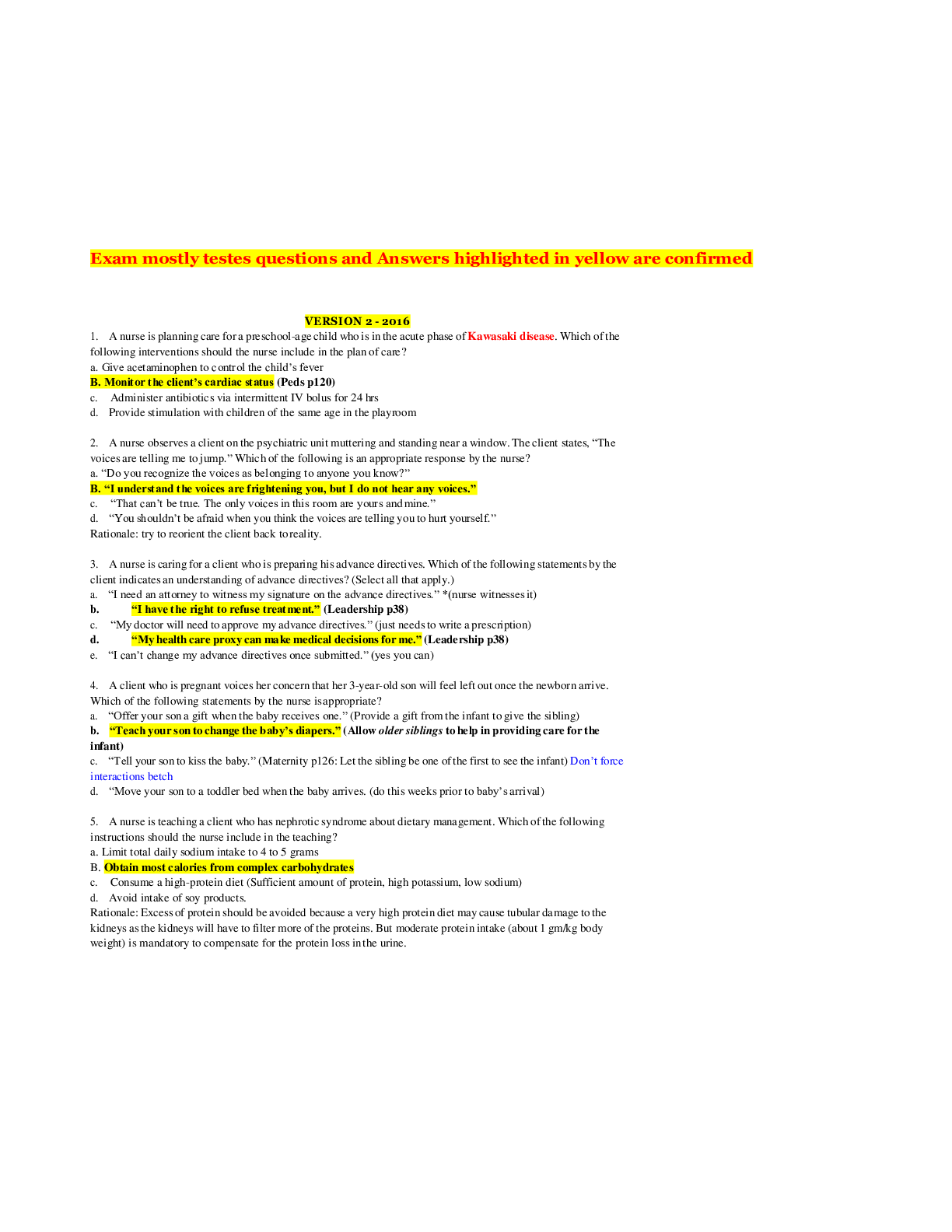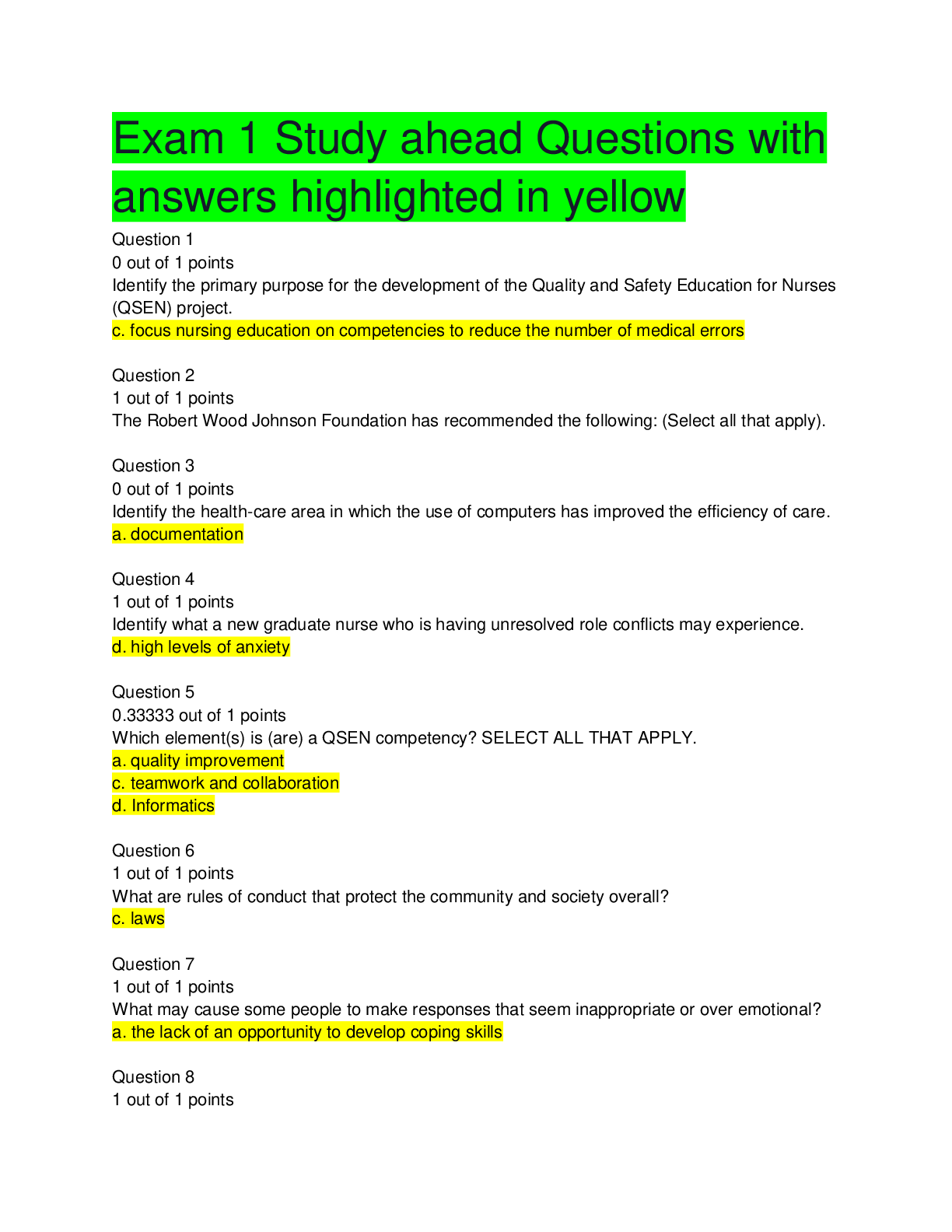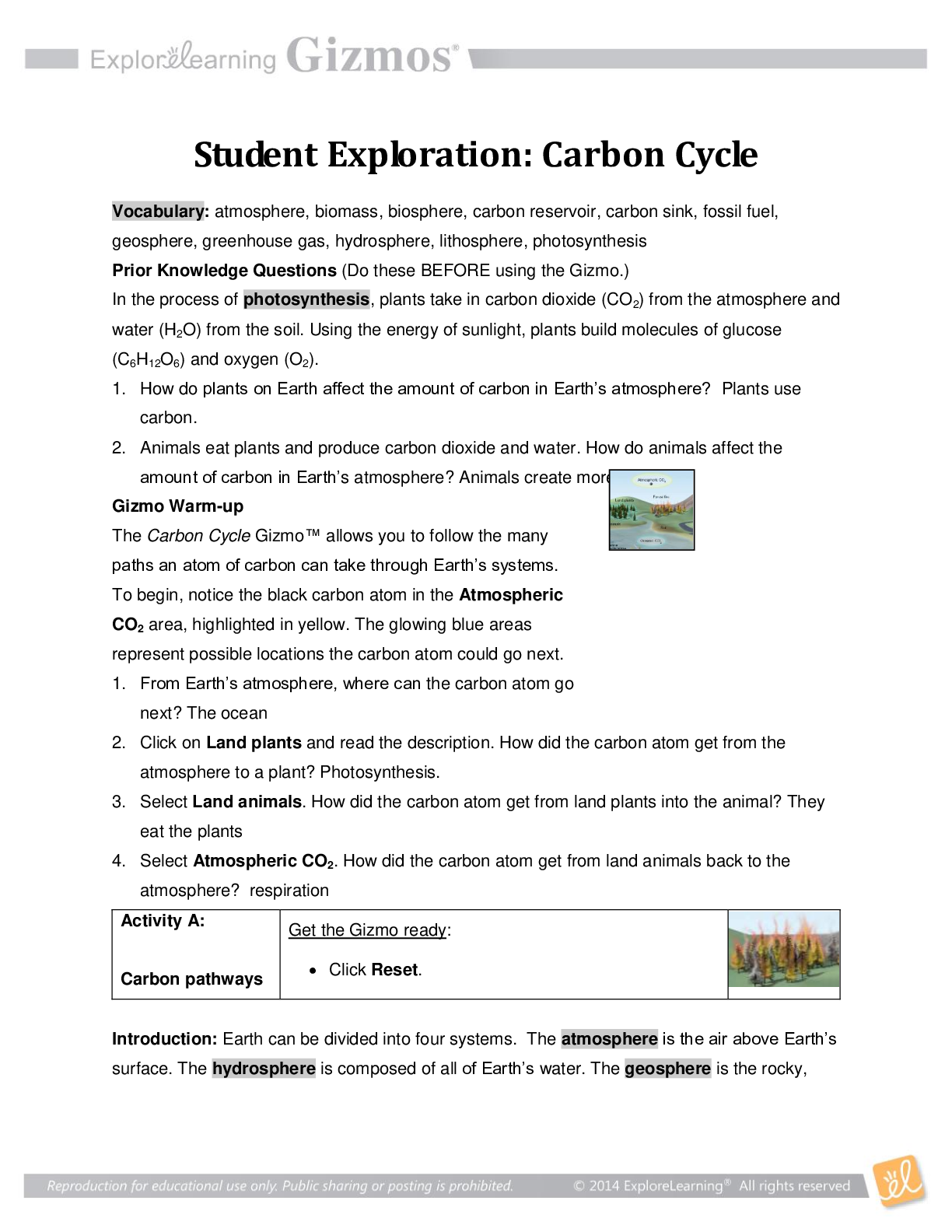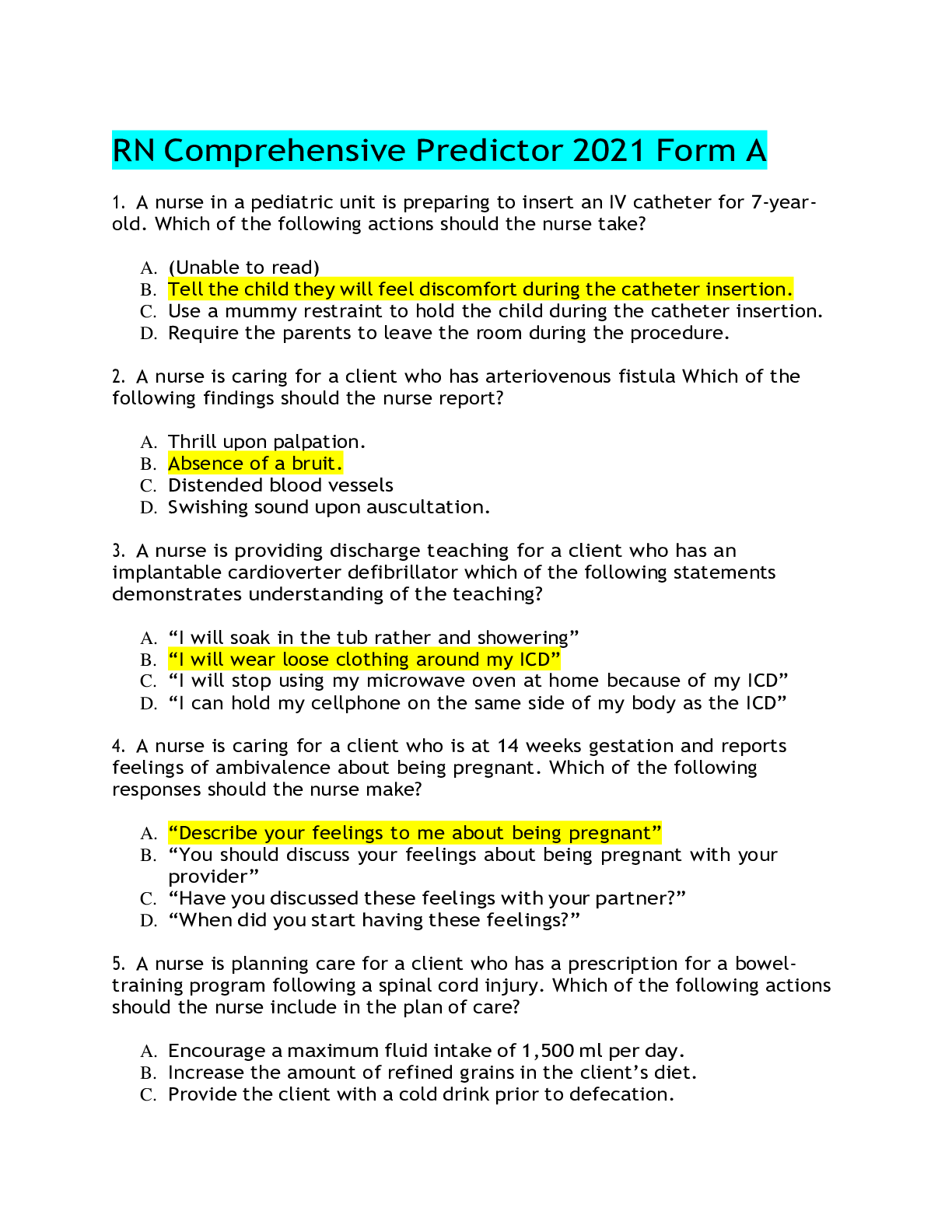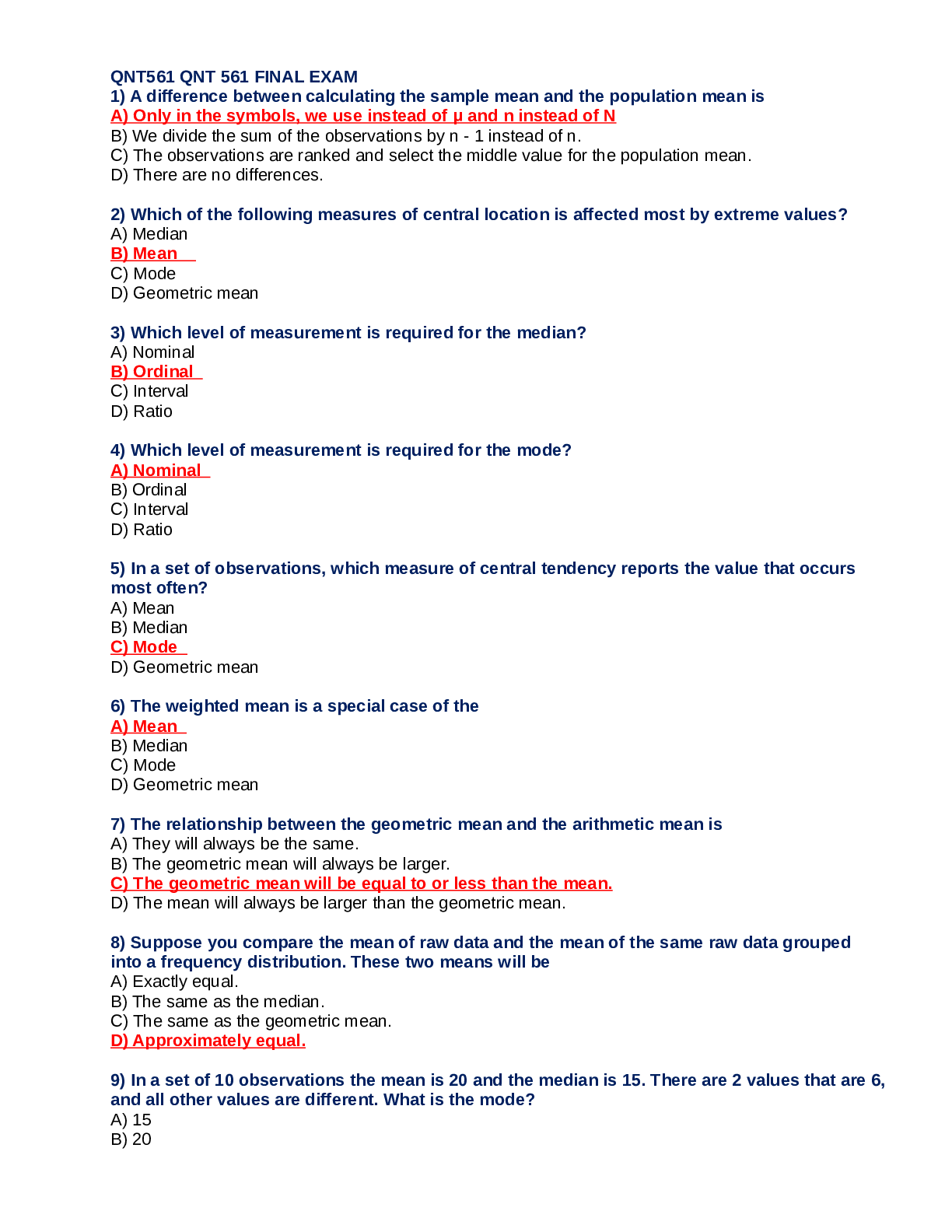*NURSING > QUESTIONS & ANSWERS > RN-EXAM COMPREHENSIVE PREDICTOR 2021 ANSWERS highlighted in yellow are confirmed (All)
RN-EXAM COMPREHENSIVE PREDICTOR 2021 ANSWERS highlighted in yellow are confirmed
Document Content and Description Below
1. A nurse is planning care for a preschool-age child who is in the acute phase of Kawasaki disease. Which of the following interventions should the nurse include in the plan of care? a. Give acetam... inophen to control the child’s fever B. Monitor the client’s cardiac status (Peds p120) c. Administer antibiotics via intermittent IV bolus for 24 hrs d. Provide stimulation with children of the same age in the playroom 2. A nurse observes a client on the psychiatric unit muttering and standing near a window. The client states, “The voices are telling me to jump.” Which of the following is an appropriate response by the nurse? a. “Do you recognize the voices as belonging to anyone you know?” B. “I understand the voices are frightening you, but I do not hear any voices.” c. “That can’t be true. The only voices in this room are yours and mine.” d. “You shouldn’t be afraid when you think the voices are telling you to hurt yourself.” Rationale: try to reorient the client back to reality. 3. A nurse is caring for a client who is preparing his advance directives. Which of the following statements by the client indicates an understanding of advance directives? (Select all that apply.) a. “I need an attorney to witness my signature on the advance directives.” *(nurse witnesses it) b. “I have the right to refuse treatment.” (Leadership p38) c. “My doctor will need to approve my advance directives.” (just needs to write a prescription) d. “My health care proxy can make medical decisions for me.” (Leadership p38) e. “I can’t change my advance directives once submitted.” (yes you can) 4. A client who is pregnant voices her concern that her 3-year-old son will feel left out once the newborn arrive. Which of the following statements by the nurse is appropriate? a. “Offer your son a gift when the baby receives one.” (Provide a gift from the infant to give the sibling) b. “Teach your son to change the baby’s diapers.” (Allow older siblings to help in providing care for the infant) c. “Tell your son to kiss the baby.” (Maternity p126: Let the sibling be one of the first to see the infant) Don’t force interactions betch d. “Move your son to a toddler bed when the baby arrives. (do this weeks prior to baby’s arrival) 5. A nurse is teaching a client who has nephrotic syndrome about dietary management. Which of the following instructions should the nurse include in the teaching? a. Limit total daily sodium intake to 4 to 5 grams B. Obtain most calories from complex carbohydrates c. Consume a high-protein diet (Sufficient amount of protein, high potassium, low sodium) d. Avoid intake of soy products. Rationale: Excess of protein should be avoided because a very high protein diet may cause tubular damage to the kidneys as the kidneys will have to filter more of the proteins. But moderate protein intake (about 1 gm/kg body weight) is mandatory to compensate for the protein loss in the urine.COMPREHENSIVE 2 !! ! 6. A nurse is interviewing an adolescent client who has a history of physical aggression due to anger management issues. Which of the following is an appropriate question by the nurse? a. “Did you think about removing yourself from the situation when you became angry?” b. “Why do you get angry when things don’t go your way?” c. “How do you think others feel when you express anger?” D. “What are you thinking about when you express anger?” (assessing the underlying issue of aggression) 7. A nurse is planning care for a client who has a sealed radiation implant and is to remain in the hospital for 1 week. Which of the following should the nurse include in the plan of care? a. Wear a dosimeter film badge while in the client’s room. (Med Surg p583) b. Ensure family members remain at least 3 feet from the client (should be at least 6ft) c. Limit each of the client’s visitors to 1 hr per day. (should be 30 minutes) d. Remove dirty linens from the room after double bagging. Keep in the room 8. A nurse is preparing to feed a newly admitted client who has dysphagia. Which of the following actions should the nurse plan to take? talaga a. Sit at or below the client’s eye level during feedings (Funds p215: Observe for aspiration and pocketing of food in the cheeks or other areas of the mouth) b. Talk with the client during her feeding c. Discourage the client from coughing during feedings (encourage pt to cough to prevent aspiration) d. Instruct the client to lift her chin when swallowing (tuck chin) 9. A nurse is caring for a preschool child who is dehydrated. Which of the following assessment findings indicates moderate dehydration? a. Bradypnea B. Oliguria (Funds p343) c. Diaphoresis d. Excessive tears 10. A nurse is providing teaching to a parent of a child who has varicella. Which of the following statements should the nurse include in the teaching? a. “Your child can return to school after a negative titer result.” b. “Your child can return to school 24 hours after beginning antibiotics.” c. “Your child can return to school once the lesions have crusted over.” d. “Your child can return to school once the fever has subsided.” 11. A nurse is providing information for a client who has a new prescription for simvastatin. For which of the following should the nurse instruct the client to monitor and report to the provider? a.! Muscle weakness - rhabdomyolysis b.! Edema c.! Weight loss d.! Fever Rationale: Simvastatin Although mild muscle pain is a relatively common side effect of statins, some people who take statin medications to lower their cholesterol may have severe muscle pain. This intense pain may be a symptom of rhabdomyolysis, a rare condition that causes muscle cells to break down. The most common signs and symptoms of rhabdomyolysis include: "! Severe muscle aching throughout the entire bodyCOMPREHENSIVE 3 !! ! "! Muscle weakness "! Dark or cola-colored urine The higher the dose of statins, the higher the risk of rhabdomyolysis becomes. The risk also increases if certain drugs — including cyclosporine (Sandimmune) and gemfibrozil (Lopid) — are taken in combination with statins. However, the risk of developing rhabdomyolysis from statin therapy is very low, around 1.5 for each 100,000 people taking statins. Rhabdomyolysis or milder forms of muscle inflammation from statins can be diagnosed with a blood test measuring levels of the enzyme creatinine kinase. If you notice moderate or severe muscle aches after starting to take a statin, contact your doctor. If you have signs and symptoms of rhabdomyolysis, stop taking your statin medication immediately and seek medical treatment right away. If necessary, your doctor may take steps to help prevent kidney damage and other complications. 12. A nurse on a medical-surgical unit is receiving report on four clients. Which of the following clients should the nurse assess first? a. A client who is receiving warfarin and has an INR of 3.3 b. A client who had an NG tube inserted 6 hrs ago and has abdominal distention c. A client who is 4 hrs postoperative following a thyroidectomy and reports fullness in the back of the throat (edema can lead to resp distress) d. A client who has acute kidney injury, a creatinine of 4 mg/dL, and a BUN of 52 mg/dL 13. A nurse is receiving report on four postpartum clients. Which of the following clients should the nurse plan to attend to first? a. A client who reports changing her perineal pad every 2 hrs b. A client who reports abdominal pain during breastfeeding c. A client who has a urine output of 250 mL in 6 hrs D. A client who has hyporeflexia while receiving magnesium sulfate 14. A nurse is providing nutritional teaching regarding appropriate food choices to a client who has a new diagnosis of uric acid calculi. Which of the following should the nurse include in the teaching? a. Roast beef b. Chicken breast c. Low-fat yogurt (avoid purine foods: organ meats & shellfish & poultry) d. Tuna fish 15. A nurse in the emergency department is caring for a client who has a full-thickness burn of the thorax and upper torso. After securing the client’s airway, which of the following is the nurse’s priority intervention? a. Preventing infection b. Offering emotional support c. Providing pain management D. Initiating IV fluid resuscitation repeat 16. A nurse is caring for a client who will undergo a procedure. The client states she does not want the provider to discuss the results with her partner. Which of the following is an appropriate response for the nurse to make? a. “The provider will be tactful when talking to your partner.” B. “You have the right to decide who receives information.” c. “Is there a reason you don’t want your partner to know about your procedure?” d. “Your partner can be a great source of support for you at this time.”COMPREHENSIVE 4 !! ! 17. A nurse is providing teaching about dietary recommendations to the parents of a school-age child who has acute kidney injury. Which of the following recommendations should the nurse include in the teaching? a. Provide low-calcium foods b. Provide high-phosphorus foods C. Provide low-potassium foods d. Provide high-sodium foods Rationale: P. 380 MS PHOSPHATE , POTASSIUM, SODIUM AND MAGNESIUM NEED TO BE RESTRICTED 18. A nurse is planning care for a school-age child who is 4 hr postoperative following perforated appendicitis. Which of the following actions should the nurse include in the plan of care? a. Apply a warm compress to the operative site every 4 hr b. Offer small amounts of clear liquids 6 hrs following surgery c. Give cromolyn nebulized solution every 8 hr D. Administer analgesics on a scheduled basis for the first 24 hrs 19. A nurse is assessing a client who is 8 hr postpartum and has been unable to void. Which of the following actions should the nurse take first? a.! Pour warm water over the client’s perineum b.! Offer the client a sitz-bath c.! Insert a sterile catheter d.! Administer an analgesic 20. A nurse is providing nutritional teaching for an older adult client who has seizure disorder and a new prescription for phenytoin. Which of the following statements by the nurse is appropriate? a. “Limit foods that contain folic acid while taking this medication.” b. “You should expect a change in the color of your stool while taking this medication.” c. “Increase your intake of vitamin D while taking this medication.” - phenytoin complication (bone pain and weakness) d. “Plan to take this medication with antacids.” 21. A nurse is assessing a client who sustained fractures to both legs in a motor-vehicle crash. Which of the following findings indicates the client is experiencing a fat embolism? a. !"#"$%&'"()*(#%"($%"+#('*,('-,)."*(/(01'$#&$"(#"+#(2345(6( b. Decreased pedal pulses c. Pain unrelieved by opioid analgesics d. Crepitus at the knee joint 22. A nurse is teaching a client who is at 41 weeks of gestation about a nonstress test. Which of the following information should the nurse include in the teaching? a. “You will have a Doppler transducer applied to your abdomen during the test.” b. “You should massage one of your nipples to stimulate contractions of your uterus.” c. “You will need blood work before and after the test.” d. “You should avoid eating or drinking for 4 hrs before the test.” 23. A home health nurse is assessing a client who has amyotrophic lateral sclerosis (ALS) and has had recent weight loss. Which of the following is the priority admission data for the nurse to obtain? TALAGA a. Changes in appetiteCOMPREHENSIVE 5 !! ! b. Daily fluid intake c. Swallowing ability - aspirations precautions d. Prescribed medications 24. A nurse is providing discharge teaching for a client who has myelosuppression following chemotherapy treatment. Which of the following statements should the nurse include in the teaching? a. “Eat a diet rich in fresh fruits and vegetables.” B. “Wear disposable gloves under gardening gloves while working with house plants.” c. “Children may visit as long as they’ve recently received a live influenza vaccination.” d. “Check your temperature weekly.” BONE MARROW SUPPRESSION- IMMUNOCOMPROMISED. AVOID 25. A nurse is caring for a client who has undergone a modified radical mastectomy. The client has a closed-suction drain. Which of the following actions should the nurse take? a. Maintain the client in supine position for the first 24 hrs b. Secure the drain to the bedding c. Reset the vacuum by compressing the container d. Position the affected extremity below the level of the client’s heart 26. A nurse is providing discharge instructions to a client who is 1-day postoperative vertical banded gastroplasty for morbid obesity. Which of the following statements demonstrates an understanding for the dietary teaching? a. “It should take me 30 to 60 minutes to eat a meal” b. “I will be limited to pureed foods for the next 6 months.” (weeks) c. “I should eat three meals per day.” d. “Vomiting is common and I will have to learn to live with it.” SERVE TO RESTRICT AND DECREASE FOOD INTAKE HELPS TO PROMOTE WT. LOSS 27. A home health nurse is visiting a client whose partner states that she is overwhelmed by caring for him. When suggesting respite care, which of the following explanations should the nurse provide? a. “Respite care offers financial resources to help care for your husband.” b. “Respite care includes volunteers who will perform household tasks.” c. “Respite care provides clinicians to work with you in caring for your husband.” D. “Respite care allows for time away from caring for your husband.” 28. A nurse is collecting a specimen for urinalysis and culture from a client who has an indwelling urinary catheter. Which of the following actions should the nurse take during collection? a. Obtain the urinalysis specimen before the culture specimen. b. Collect 2 mL or urine for each specimen. c. Drain the specimen from the drainage bag. D. Clamp the catheter distal to the injection port. 29. A nurse is caring for four clients. Which of the following clients should the nurse care for first? a. A client who has hypothyroidism and is stuporous b. A client who has a burn requiring a sterile dressing change c. A client who received a chemotherapy treatment and reports nausea d. A client who had an appendectomy 2 days ago and has diminished bowel sounds Rationale: Myxedema Coma. Myxedema coma is a rare, life-threatening complication of untreated hypothyroidism. Symptoms include a severe drop in body temperature (hypothermia), delirium, reduced lung function, slow heartCOMPREHENSIVE 6 !! ! rate, constipation, urine retention, seizures, stupor, fluid build-up, and finally coma. It is uncommon, but may develop in untreated patients subjected to severe stress, such as infection, surgery, or extreme cold. 30. A nurse is caring for a client who states he recently purchased lavender oil to use when he gets the flu. The nurse should recognize which of the following findings as a potential contraindication to using lavender? a. The client has a history of alcohol use disorder b. The client has a history of asthma- Lavender is known to decrease inflammation - IT HELPS ON ASTHMA c. The client takes Vitamin C daily D. The client takes furosemide twice daily- Lavender reduced blood pressure, furosemide does the same [Show More]
Last updated: 1 year ago
Preview 1 out of 83 pages
Instant download
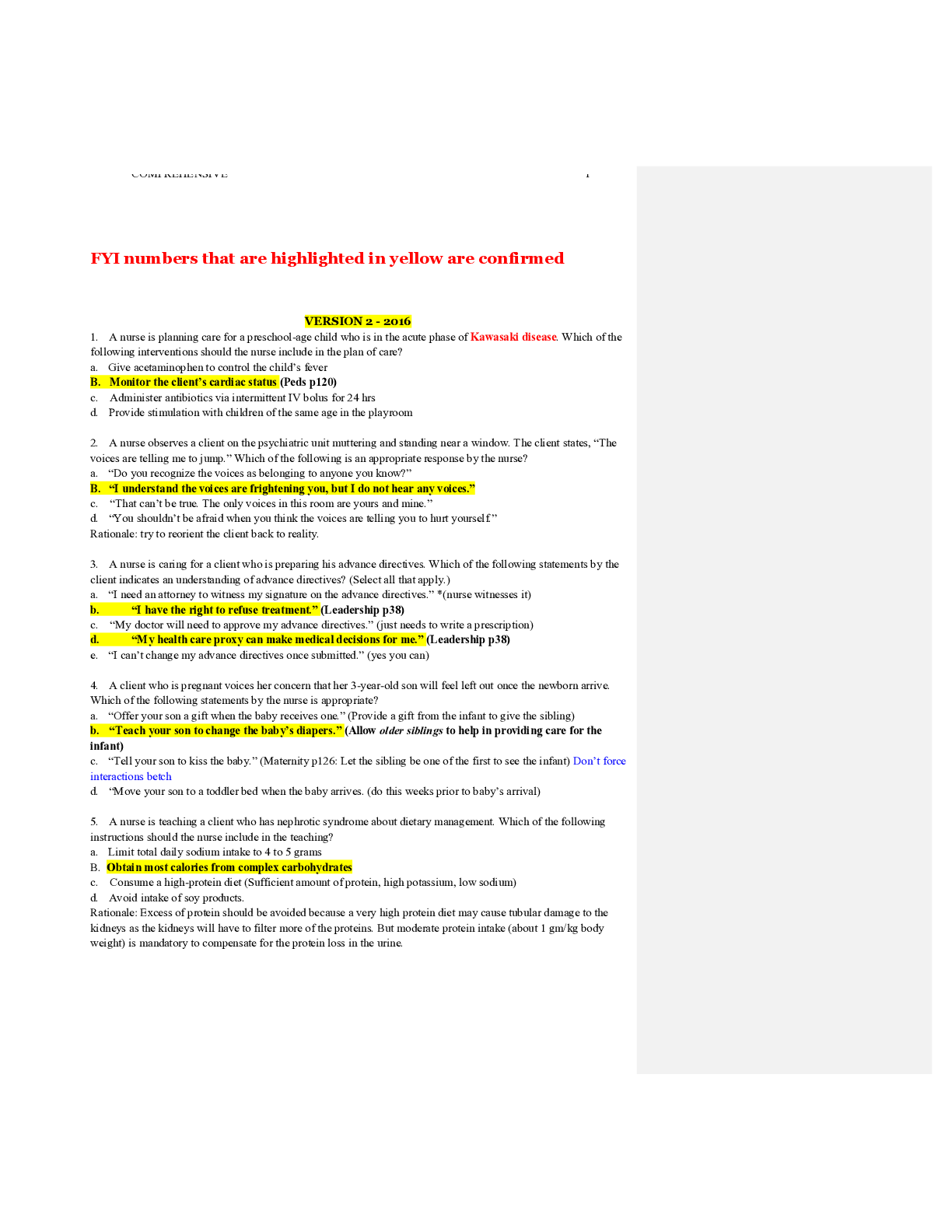
Buy this document to get the full access instantly
Instant Download Access after purchase
Add to cartInstant download
Reviews( 0 )
Document information
Connected school, study & course
About the document
Uploaded On
Aug 14, 2021
Number of pages
83
Written in
Additional information
This document has been written for:
Uploaded
Aug 14, 2021
Downloads
1
Views
139



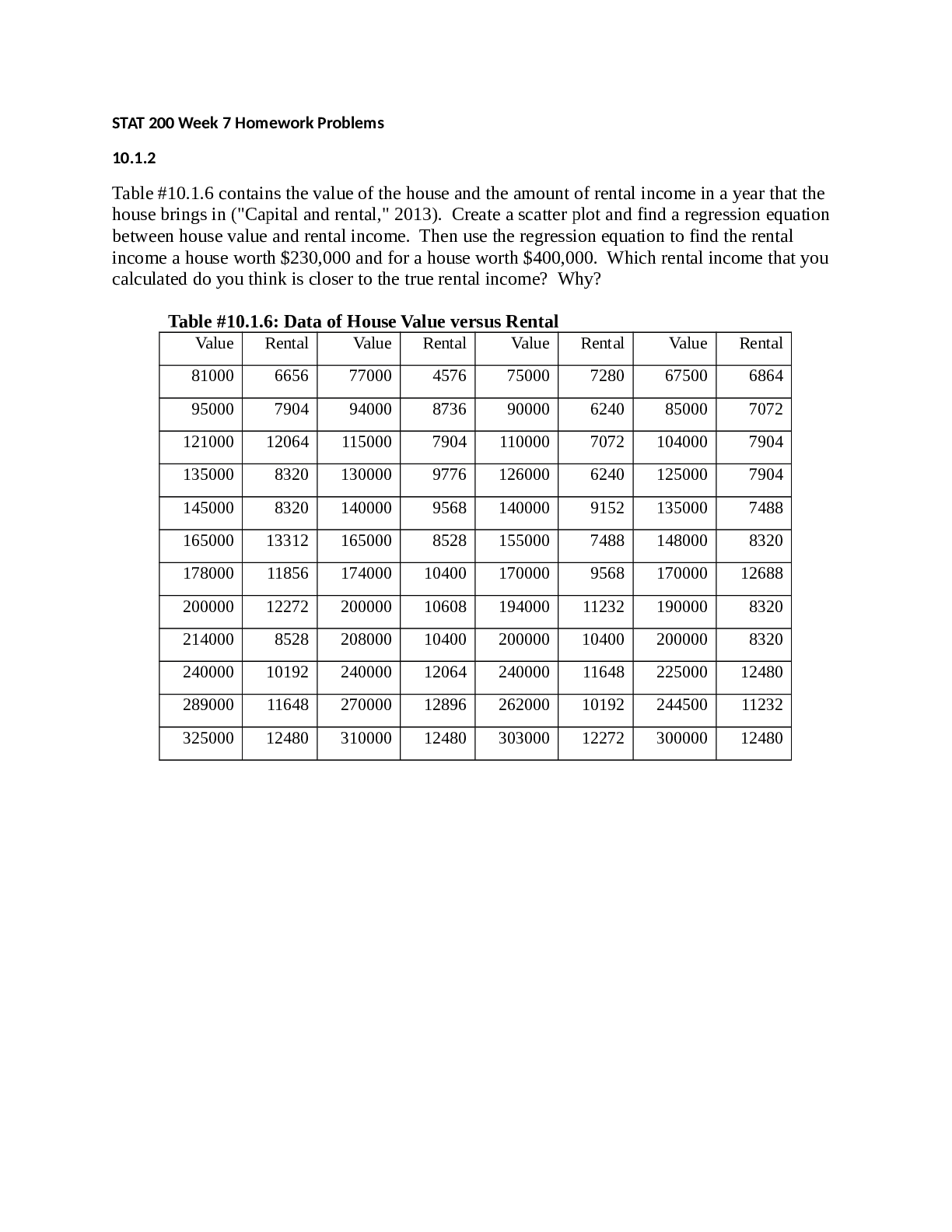
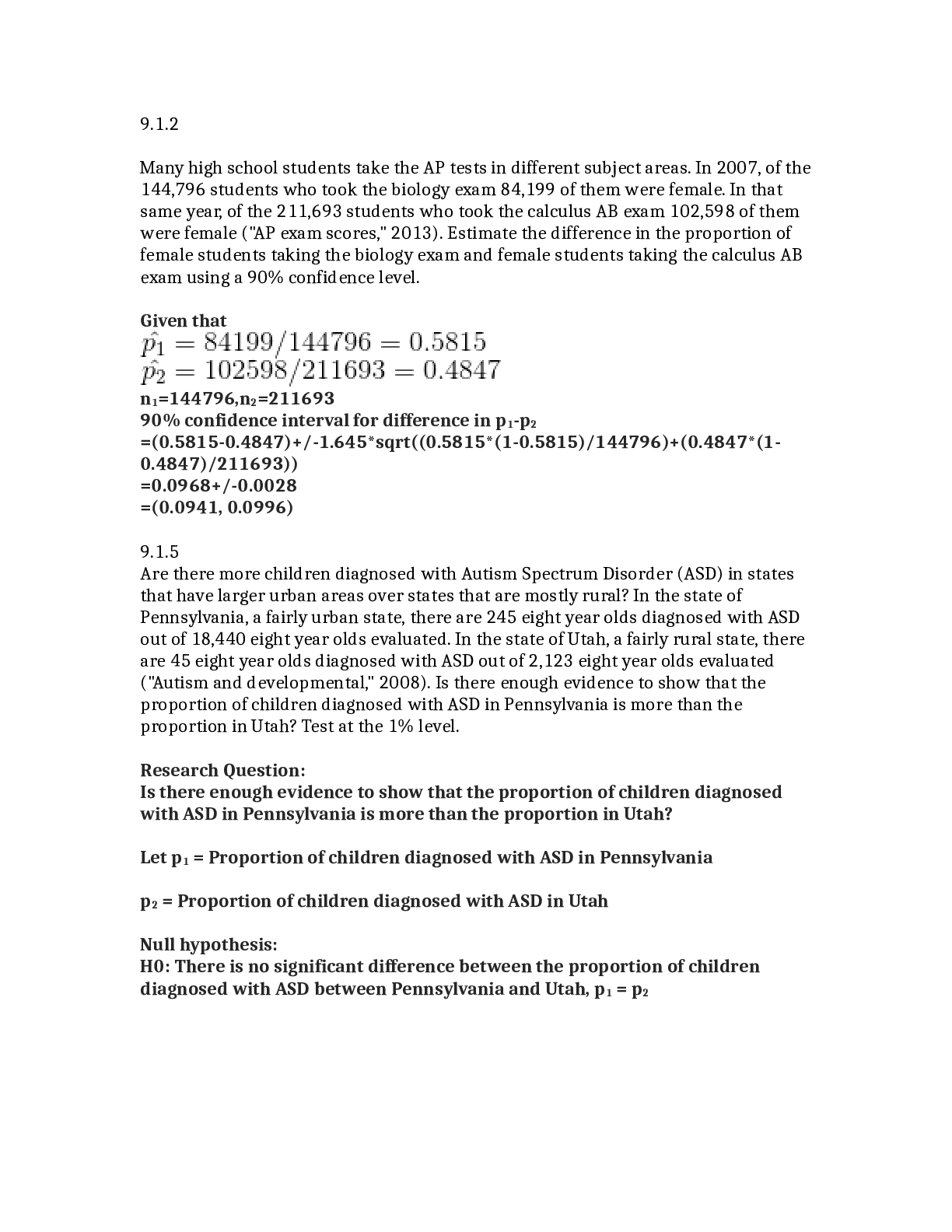



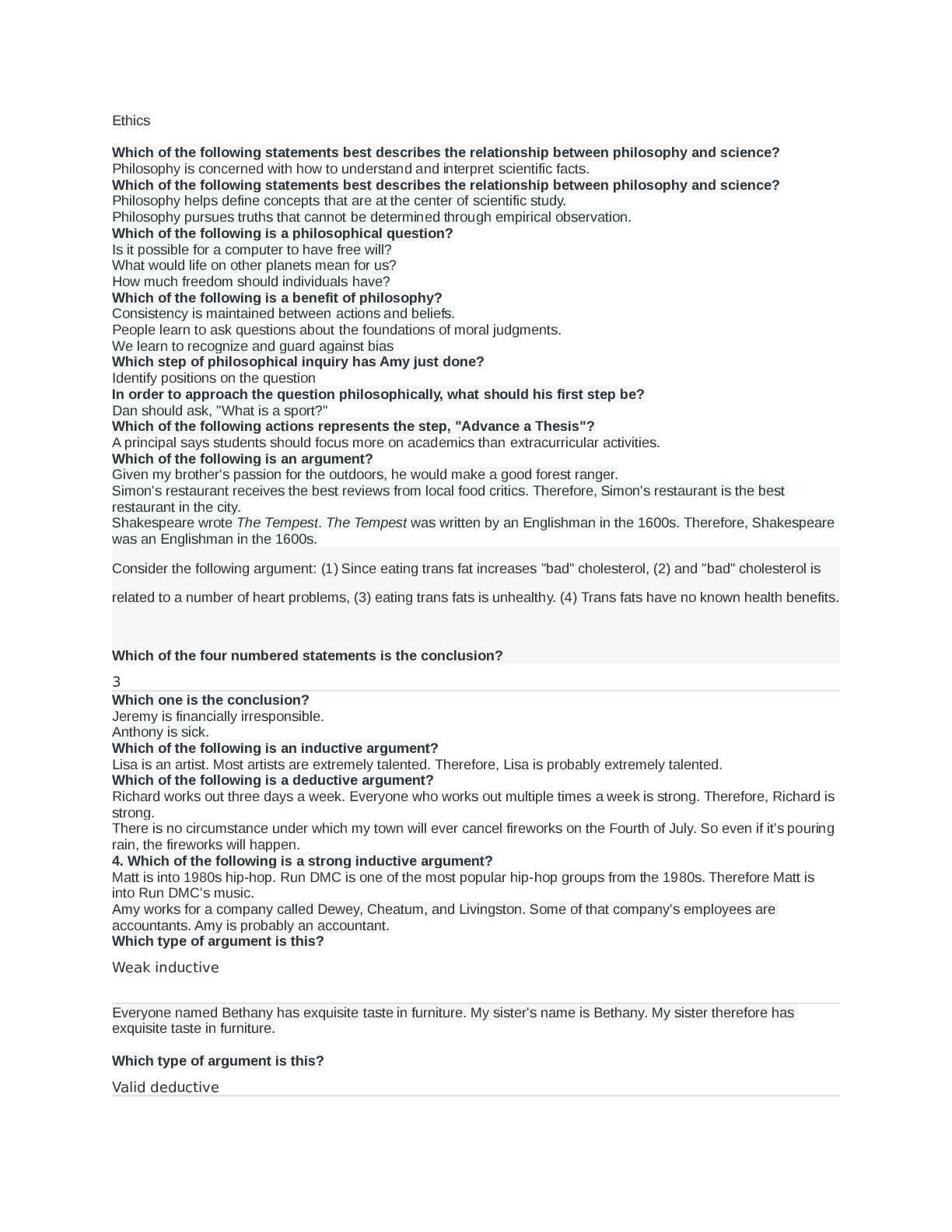

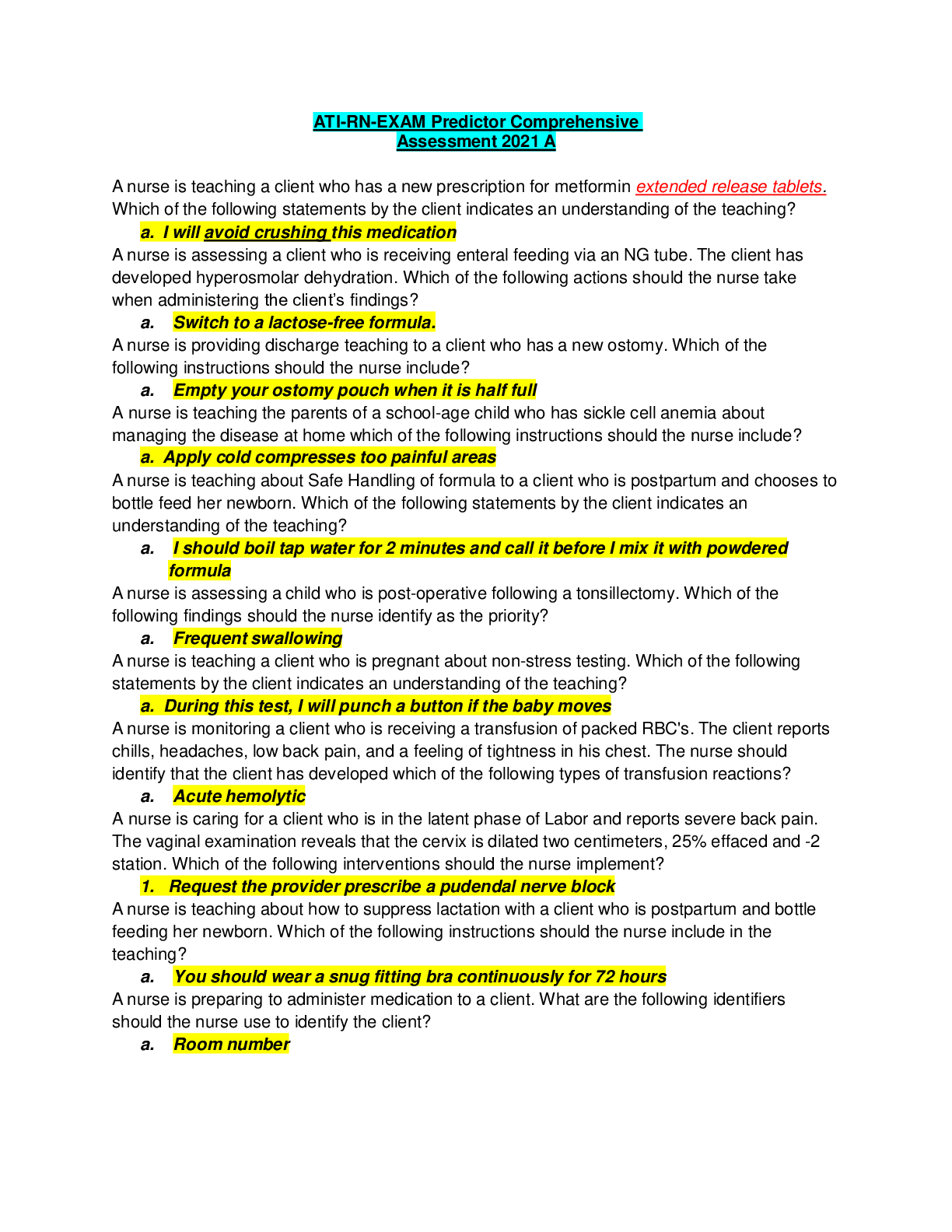

.png)
